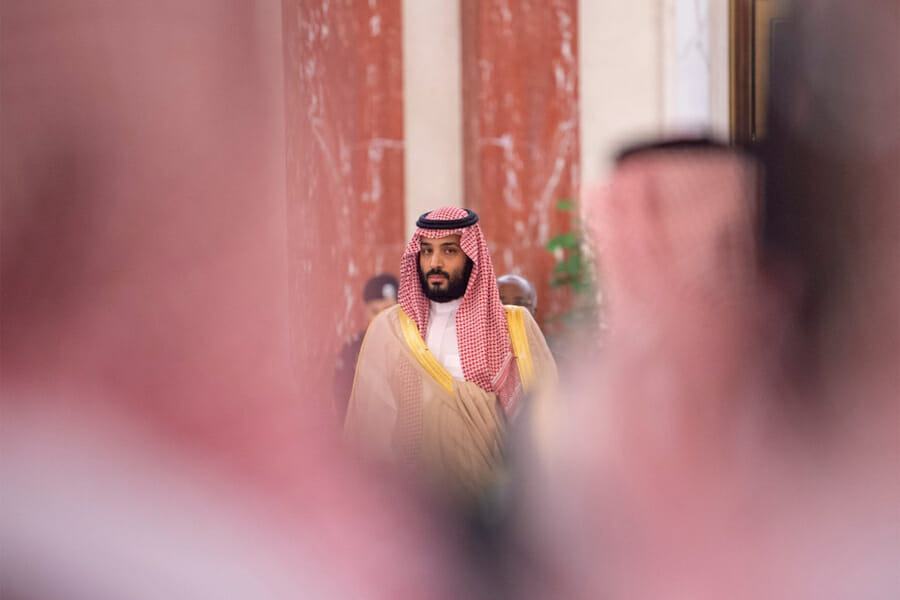
Shaping Saudi Arabia’s Geopolitical Behavior
Situated at the heart of the Arabian Peninsula, the Kingdom of Saudi Arabia is known for its output of hydrocarbon resources, close proximity to some of the world’s busiest maritime traffic lanes, and the custodian of the two holiest sites of Islam (Mecca and Medina). Yet, the desert is the most distinguishable geographic feature of Saudi Arabia. There are three particular deserts that cover a large portion of the country. One of the deserts is the An-Nafud in the north, which is a desolate mass of sand where violent winds have shaped large crescent-like dunes. The An-Nafud is connected to the Ad-Dahna desert which is a narrow corridor of sand that stretches to the south linking the Rub-al-Khali desert. Considering the costs of the expensive but necessary infrastructure, the extraction of oil in the Rub-al-Khali desert would yield no profits with the current oil prices. On the positive side, all three deserts form solid barriers that extend into the neighboring countries of Iraq, Jordan, Kuwait, Oman, Qatar, the United Arab Emirates, and Yemen.
Further east by the Persian Gulf, the terrain flattens and forms the Al-Hasa region. Some of the major population zones in this region include the cities of Dammam, Hofuf, Al-Jubayl, and Qatif. These eastern cities and their surroundings are rich in hydrocarbon resources and most of Saudi oil is extracted and transported from here. As such, the Al-Hasa region forms the backbone of the Saudi economy, and petroleum wealth has allowed the Saudis to weather the instability throughout the Middle East. However, low oil prices have reversed the kingdom’s financial well-being. Its sovereign wealth fund, once the third largest in the world has dropped from $736 billion in 2015 to $500 billion in 2018 due to the annual 20% budget deficits. Although the Saudi reserves remain substantial if the situation persists and no economic reforms are implemented, oil-rich Saudi Arabia could run out of money within a few years. As such, the Saudis recognize economic reform as a top priority and the government has an ambitious plan to attract foreign investment to its private sector. Yet, the roadmap requires nothing less than a complete overhaul of the social-political structure of the kingdom.
As dreadful as the economic situation is in Saudi Arabia, finances don’t necessarily worry the Saudis. The kingdom faces a multitude of geopolitical challenges internally and externally. One of the most pressing internal dilemmas is the high concentration of Shia in the Al-Hasa region where much of the Saudi oil revenues originate. The Shia faith, which is in stark contrast to the ultra-conservative Wahhabi doctrine is presumed to account for at least 15% of the population. In addition to Shias, foreign workers from South Asia also constitute a minority faction. Foreign workers are spread throughout Saudi Arabia and account for nearly a fifth of the population. Yet, like the Shia minority, foreign workers are treated as second-class citizens with very little civil liberties like other Saudis. The Saudi leadership fears that the interaction between the minorities and the outside world could ignite sectarian violence at the economic heart of the kingdom. The fact that militant groups have tried to destabilize the polarized landscape by staging attacks on Shia mosques only confirms that suspicion. Of all things considered, the risks posed to the economic core in the Al-Hasa region is a vulnerability that the Saudi leadership must address with a viable long-term solution.
On the opposite side of Saudi Arabia lies the Hejaz highlands. In this area, two mountainside ranges dominate the countryside along the Red Sea, namely the Asir Mountains in the southwest and the Hejaz range in the northwest. Spread throughout the area are small springs and valleys which make this side of Saudi Arabia more hospitable. In fact, most of the kingdom’s population of 33 million resides within 150 kilometers of the Red Sea. The densest concentration of Saudis live near the border with Yemen, and the same is true on the other side of the border as a substantial portion of the Yemeni population live within 150 kilometers of the Saudi border. The issue here is that both sides of the heavily populated Saudi-Yemeni border are primarily inhabited by followers of Shia Islam much like the Shia Muslim presence in the Eastern Province. This is a dilemma for the Saudi Government because the cross-border ties exposed the southwest of the country to foreign influence. Iran with its cultural, diplomatic, economic soft power and proxy groups is of particular concern for the Saudis. As such, retaining stability along its borders is the foremost political objective in the Hejaz highlands.
The Hejaz region also offers the Saudis an opportunity to diversify its economy. The Red Sea coastline hosts several stopping points along the global trading routes. With the right business climate, the Saudi ports could offer a substantial economic opportunity because the ports are still in their infancies and therefore have a lot of room to grow in insurances, services, and fees. With this potential in mind, the Saudi leadership is planning to double the cargo capacity in its main port of Jeddah, which will also be linked to a nationwide railway system known as the land bridge project. Further along the coast, the Saudis are constructing the King Abdullah Economic City whose port, upon completion, will have ten times the cargo capacity of the port in Jeddah. However, the trouble with these projects is that the NEOM mega city project has shifted the government’s priorities in a different direction. This has left other projects hanging and if the issue is not addressed, the ports in Jeddah and King Abdullah, as well as the land bridge project will never be completed. The Saudis will have to streamline their competing mega projects in order to construct a shipping industry along the Red Sea.
Elsewhere in the Hejaz region, there are several important sites including the holy cities of Mecca and Medina. In addition to their religious significance, the cities give the House of Saud legitimacy to reign over the country. Thus, the relationship between the religious establishment and the ruling dynasty is a fundamental component of the Saudi Government. To ensure the security of the holy cities and the legitimacy of the state, the Saudis need to retain control over several other sites. The first is the port city of Jeddah which is the second largest city in the kingdom and sits around 60 kilometers from Mecca. Overlooking both cities is Ta’if which is cooler than the other parts of the country due to its elevation and climate. Ta’if also functions as the de-facto summer capital for the political elite. Altogether, Mecca, Jeddah, and Ta’if form the densest area of the country, and maintaining control of the three cities secures the Saudi coastline by the Red Sea.
Meanwhile, Medina is less complicated. The security of the city is ensured by its inland location, but from Medina to its northeast lies Arabia’s longest valley known as Wadi-al-Rum. A river used to flow from the valley to the Persian Gulf, but the valley is mostly dry and obstructed to sand dunes. Nevertheless, the valley encouraged human activity in the center of the Arabian Peninsula. The central area known as the Najd region hosts the capital Riyadh. However, as the political heart of the Saudi kingdom, Riyadh is strikingly isolated from the rest of the country. Only half of the total population lives within a 500-kilometer radius of the capital while the other half lives in the borderlands. This distance in combination with the geographical differences greatly disrupts the internal cohesion within the kingdom. For instance, the landlocked isolation of Najd has formulated an ultra-conservative entity while the global interaction of Mecca, Jeddah, and Medina has formed a more cosmopolitan culture in Hejaz. At the same time, in the Al-Hasa region, a minority with non-Sunni traditions have more in common with foreigners across the Persian Gulf than with Riyadh. No other nation in the Middle East has an odd demographic layout than Saudi Arabia, and this geopolitical vulnerability illustrates how susceptible the kingdom is to foreign influence.
An equally complicated internal issue for Saudi Arabia is the transition of the monarch to the third-generation leadership. The manner in which King Salman elevated his son Mohammed bin Salman as the Crown Prince and Defense Minister at the expense of other experienced family members has created frictions within the ruling dynasty. The political elite has disagreed over MBS’s ability to govern, and the future monarch will have to find ways to smoothen the transition of power by keeping the royal family satisfied while implementing political, social, and economic reforms. This will prove to be a daunting challenge.
Beyond its internal issues, Saudi Arabia faces several external dilemmas. For instance, the Red Sea and the Persian Gulf are both choke points that can be closed off by rival powers like Iran. The most pressing choke point is the Strait of Hormuz through which about a fifth of the world’s petroleum passes. At its narrowest crossing, the strait is one of the most strategic and volatile choke points in international trade. Saudi Arabia exports around eight million barrels of oil each day through the Strait of Hormuz and this amount represents a great deal of the country’s state revenues. Hence, ensuring the freedom of navigation in its immediate waters is a paramount geopolitical objective for Saudi policymakers.
Since the Saudis lack the naval strength to accomplish this goal, they rely on the United States to keep the Hormuz Strait open. During the Cold War, the United States provided security while the Saudi Kingdom kept the oil flowing. Yet, alliances are give-and-take relationships and as new technologies emerge for hydrocarbon extraction, Washington will become less dependent on oil from the Middle East. In the long-term, the Saudis may not be able to offer the US anything of value which will fundamentally alter the relationship. Policymakers in Riyadh are taking the necessary steps for such a scenario. This is evident from the massive weapons deals with western nations. The problem, however, is that most of the newly purchased military hardware is not operated by Saudi personnel because the Saudi leadership doesn’t trust its own military commanders. Instead, the weapons are stored across the country with the idea that the US will operate them, should the need set in. This concept may have worked during the Cold War, but it is outdated in modern times. In the long-term, Saudi Arabia will not only have to find new partners but also form an indigenous military force.
Due to the sheer volume of domestic and foreign vulnerabilities, Saudi policymakers believe that they must fight for their interests beyond their borders. The unfortunate result of Riyadh’s interventionist foreign policy can be seen in the covert and overt operations from Doha to Tripoli and Beirut to Sana’a. Along its western and eastern borderlands in the Al-Hasa region and the Hejaz highlands, the Saudi government must ensure its hold. The major cities in the west are necessary for political legitimacy while the cities in the Eastern Province grant economic advantages. The ensuing objective for the Saudis is to redesign the economy by enacting social and political reforms. To this end, the coastline by the Red Sea has enormous potential for shipping and Riyadh is already working on numerous mega projects. However, the Saudi Government must fine-tune these projects. All of these dramatic changes are occurring at a time when the monarchy is preparing for the transition of power to the third generation which is the kingdom’s subsequent objective. How this will play out remains uncertain, but the road ahead is unlikely to go exactly as planned. Meanwhile, the kingdom will safeguard the freedom of navigation in its immediate waters. Yet, to accomplish this, Riyadh needs Washington, but in the long-term, the two are likely to go their separate ways and the Saudis must forge new alliances to maintain a balance with their rivals.
